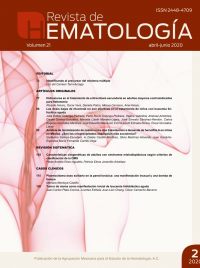Breast cancer as initial manifestation of acute lymphoblastic leukemia.
Rev Hematol Mex. 2020 abril-junio;21(2):120-126. https://doi.org/10.24245/rev_hematol.v21i2.3707
Juan Carlos Plata-Corona, Lourdes Esthela Juan-Lien Chang, César Camacho-Becerra
Departamento de Medicina Interna y Hematología, Hospital General Zona Sur Puebla, Puebla, México.
Resumen
ANTECEDENTES: La infiltración extramedular aislada de la leucemia linfoblástica aguda en adultos como manifestación inicial es poco común y representa un reto diagnóstico y terapéutico. A pesar de que la leucemia linfoblástica aguda es capaz de infiltrar cualquier órgano, lo más común es que lo haga al sistema nervioso central y al testículo; la infiltración a tejido mamario es una localización excepcional.
CASO CLÍNICO: Paciente femenina de 34 años, quien inició su padecimiento con dos lesiones tumorales en la mama derecha; se protocolizó de inicio como probable cáncer de mama, posteriormente se agregó síndrome purpúrico, hemorragíparo y febril; se reportó pancitopenia en la citometría hemática; fue tratada entonces por el servicio de Hematología, en donde se realizó frotis de sangre periférica, aspirado de médula ósea, punción con aguja fina y análisis citológico de la lesión. Se evidenciaron blastos en sangre periférica y en médula ósea, correspondientes por morfología a leucemia linfoblástica aguda L3, el análisis citológico de la punción con aguja fina mostró también blastos; se concluyó finalmente el diagnóstico de leucemia linfoblástica aguda L3 con infiltración a la mama como manifestación inicial.
CONCLUSIÓN: La infiltración de leucemia linfoblástica aguda a la mama es muy rara y debe tenerse en cuenta entre los diagnósticos diferenciales de malignidad. En un contexto adecuado, la punción con aguja fina facilita el diagnóstico y permite evitar biopsias que condicionen secuelas en pacientes jóvenes.
PALABRAS CLAVE: Leucemia linfoblástica aguda; tumor de mama; punción con aguja fina.
Abstract
BACKGROUND: Extramedullary infiltration of acute lymphoblastic leukemia (ALL) in adults as an initial manifestation is rare and represents a diagnostic and therapeutic challenge. It is known that ALL is able of infiltrating any organ, the most common is central nervous system and testicle, breast infiltration is an exceptional location.
CLINICAL CASE: A 34-year-old woman, whose clinical condition started with two tumor lesions in the right breast which were initially documented as probable breast cancer, eventually developed purpuric, hemorrhagic and febrile syndrome; patient was then protocolized by the hematology department, peripheral blood smears, bone marrow aspirate and fine-needle aspiration cytology (FNAC) was performed. The presence of blasts in peripheral blood and bone marrow was concluded, corresponding by morphology to ALL L3, the cytological analysis of FNAC also identified blasts, and it was finally diagnosed of ALL L3 with breast infiltration.
CONCLUSION: Breast infiltration by ALL is rare. It should be considered in the differential diagnosis of malignancy. In an appropriate context fine-needle aspiration cytology is an acceptable method to establish diagnosis and may avoid unnecessary surgical biopsies that condition sequels in young female.
KEYWORDS: Acute lymphoblastic leukemia; Breast tumor; Fine-needle aspiration.

